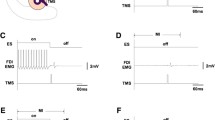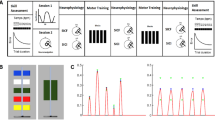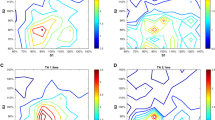Abstract
Previous studies have clearly shown that motor imagery modulates corticospinal excitability. However, there is no clear evidence for the modulation of intracortical inhibition (ICI) during imagined task performance. The aim of this study was to use transcranial magnetic stimulation (TMS) to assess changes in corticospinal excitability and ICI during the imagined performance of two types of task. In Experiment 1, eight subjects performed phasic depression of a computer mouse button using the dominant index finger in time with a 1 Hz auditory metronome. Single and paired pulse magnetic stimuli were delivered at rest, and during the ‘on’ and ‘off’ phases of actual and imagined task performance. Motor evoked potentials (MEPs) were recorded from FDI and APB. In Experiment 2, eight subjects performed phasic isometric abduction of the dominant thumb in time with a 1 Hz auditory metronome. As before, single and paired pulse magnetic stimuli were delivered at rest, and during the ‘on’ and ‘off’ phases of actual and imagined task performance. In both experiments, the conditioning stimulus intensity was set to produce 50% inhibition at rest, to enable both increases and decreases in ICI during task performance to be detected. No significant temporal or spatial modulation of MEP amplitude or ICI was observed in Experiment 1. In contrast, MEP amplitude was significantly greater, and ICI significantly lower during the ‘on’ phase of imagined task performance in Experiment 2. These results are most likely related to the higher levels of target muscle activation required during actual task performance and the greater anatomical distance between target and control muscles in Experiment 2. These task characteristics may influence the observed degree of corticospinal excitability and ICI modulation.









Similar content being viewed by others
References
Abbruzzese G, Assini A, Buccolieri A, Marchese R, Trompetto C (1999) Changes of intracortical inhibition during motor imagery in human subjects. Neurosci Lett 263:113–116
Bruning JL, Kintz BL (1987) Computational handbook of statistics. Scott, Foresman and Company, Glenview, IL
Decety J (1996) Do imagined and executed actions share the same neural substrate? Cog Brain Res 3:87–93
Devanne H, Lavoie BA, Capaday C (1997) Input-output properties and gain changes in the human corticospinal pathway. Exp Brain Res 114:329–338
Facchini S, Muellbacher W, Battaglia F, Boroojerdi B, Hallett M (2002) Focal enhancement of motor cortex excitability during motor imagery: a transcranial magnetic stimulation study. Acta Neurol Scand 105:146–151
Fadiga L, Buccino G, Craighero L, Fogassi L, Gallese V, Pavesi G (1999) Corticospinal excitability is specifically modulated by motor imagery: a magnetic stimulation study. Neuropsychologia 37:147–158
Fisher RJ, Nakamura Y, Bestmann S, Rothwell JC, Bostock H (2002) Two phases of intracortical inhibition revealed by transcranial magnetic threshold tracking. Exp Brain Res 143:240–248
Hanakawa T, Immisch I, Toma K, Dimyan M, van Gelderen P, Hallett M (2003) Functional properties of brain areas associated with motor execution and imagery. J Neurophysiol 89:989–1002
Hashimoto R, Rothwell JC (1999) Dynamic changes in corticospinal excitability during motor imagery. Exp Brain Res 125:75–81
Jackson PL, Lafleur MF, Malouin F, Richards C, Doyon J (2001) Potential role of mental practice using motor imagery in neurologic rehabilitation. Arch Phys Med Rehabil 82:1133–1141
Johnson SH (2000) Imagining the impossible: intact motor representations in hemiplegics. Neuroreport 11:729–732
Kasai T, Kawai S, Kawanishi M, Yahagi S (1997) Evidence for facilitation of motor evoked potentials (MEPs) induced by motor imagery. Brain Res 744:147–150
Kiers L, Fernando B, Tomkins D (1997) Facilitatory effect of thinking about movement on magnetic motor-evoked potentials. Electroencephalogr Clin Neurophysiol 105:262–268
Li CR (2000) Impairment of motor imagery in putamen lesions in humans. Neurosci Lett 287:13–16
Liepert J, Classen J, Cohen LG, Hallett M (1998) Task-dependent changes of intracortical inhibition. Exp Brain Res 118:421–426
Oldfield RC (1971) The assessment and analysis of handedness: the Edinburgh inventory. Neuropsychologia 9:97–113
Reynolds C, Ashby P (1999) Inhibition in the human motor cortex is reduced just before a voluntary contraction. Neurology 53:730–735
Ridding MC, Rothwell JC (1999) Afferent input and cortical organisation: a study with magnetic stimulation. Exp Brain Res 126:536–544
Ridding MC, Taylor JL, Rothwell JC (1995) The effect of voluntary contraction on cortico-cortical inhibition in human motor cortex. J Physiol 487:541–548
Rossi S, Pasqualetti P, Tecchio F, Pauri F, Rossini PM (1998) Corticospinal excitability modulation during mental simulation of wrist movements in human subjects. Neurosci Lett 243:147–151
Rossini PM, Rossini S, Pasqualetti P, Tecchio F (1999) Corticospinal excitability modulation to hand muscles during movement imagery. Cereb Cortex 9:161–167
Stinear CM, Byblow WD (2003a) Motor imagery of phasic thumb abduction temporally and spatially modulates corticospinal excitability. Clin Neurophysiol 114:909–914
Stinear CM, Byblow WD (2003b) Role of intracortical inhibition in selective hand muscle activation. J Neurophysiol 89:2014–2020
Yahagi S, Kasai T (1998) Facilitation of motor evoked potentials (MEPs) in first dorsal interosseous (FDI) muscle is dependent on different motor images. Electroencephalogr Clin Neurophysiol 109:409–417
Acknowledgement
CMS is supported by the Foundation for Research, Science and Technology. This project was supported by grants from Mr. P. Baines, the University of Auckland Graduate Research Fund, and the Neurological Foundation of New Zealand.
Author information
Authors and Affiliations
Corresponding author
Rights and permissions
About this article
Cite this article
Stinear, C.M., Byblow, W.D. Modulation of corticospinal excitability and intracortical inhibition during motor imagery is task-dependent. Exp Brain Res 157, 351–358 (2004). https://doi.org/10.1007/s00221-004-1851-z
Received:
Accepted:
Published:
Issue Date:
DOI: https://doi.org/10.1007/s00221-004-1851-z




